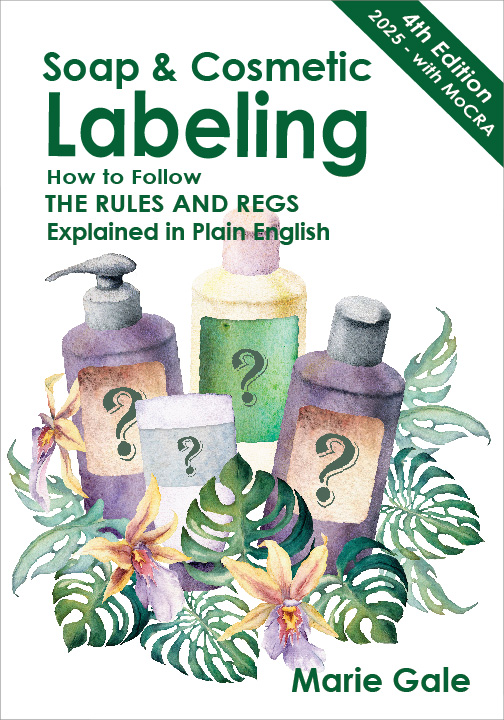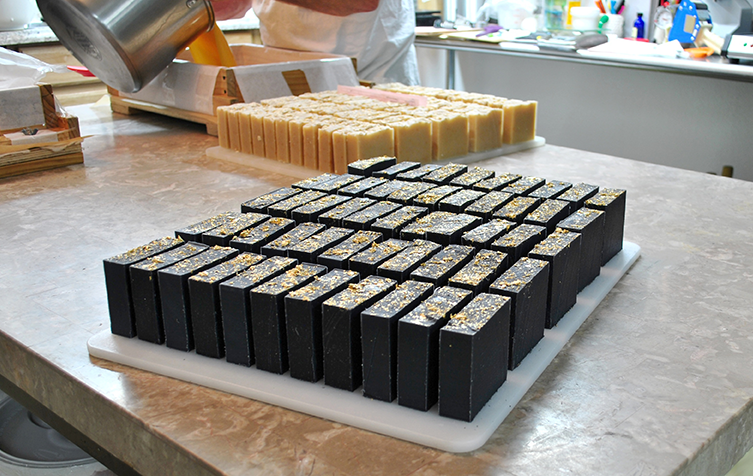In Part 1 of this series, we discussed how to calculate the net weight of your soap over time by weighing actual bars and seeing what happened to them. That works if you know where your soap will be and can rely on the fact that the environment won’t change much.
If your soap may be in a retail shop somewhere, or if the environment in which you store it could change (due to weather or time of year, for example), then it won’t work to use what has happened to the soap to predict what will happen to the soap. In that case, you need a different way to calculate what the net weight of the soap will be when it is sold.
Weight Loss from Water Evaporation
Soaps get lighter and smaller over time, primarily due to water evaporation.
While some volatiles (such as essential oils) can also evaporate, the bulk of the weight loss is from a reduction of the amount of water remaining in the soap as it dries out.
In this method of calculating the net weight over time, we determine what remains in the soap when all, or nearly all, of the water is gone.
Water Percentage
The first thing to calculate is the percentage (by weight) of water in your soap formulation. In order for this to work, it’s important that you know the actual weight of every ingredient that goes into the soap.
- Add up the weight of all the ingredients in the batch, including the water.
- Divide the weight of the water in the batch by the total weight of the batch.
That gives you the percentage of water in your batch (by weight). It will be an amount less than 0 by decimal point; multiply by 100 to get the percentage.
Example:

Total Water Evaporation
That calculation tells you how much lighter the soap would be if ALL the water evaporated out of it. In the example above, each bar of soap from that batch would weigh 21% less than the original weight (when first made).
Using that number, you can determine the the lowest weight your soap could possibly reach.
Granted, it’s unlikely that every little bit of water will evaporate out of the soap before it’s sold. But it could! I have a bar of coconut soap from the 1940’s, and it is dry as a bone. I doubt there is any water at all in it … but then, that soap is over 80 years old and made with coconut oil only, so it never went rancid.
Determining the Net Weight for the Label
- Take a bar of soap (or several, to get an average) and weigh it right after you unmold and trim it (before any drying or curing time).
- Multiply that by the percentage of water to get the amount of water in the bar. If your calculator doesn’t have a percentage function, convert the percentage to decimal for the calculation (e.g., 21% = .21)
- Subtract the water amount from the total weight.
That gives you the lowest possible weight for the soap.
Example:
5 oz bar of soap with 21% water


Best Practice
The absolutely safest way to label your soap is to use that weight for the net weight on the label.
Making Adjustments
If you think that your soap will sell before all the water is evaporated out of it, you could adjust up a little in the net weight, but realize that you are making a guess, albeit (hopefully) an educated guess. But don’t get carried away.
If you have also calculated the weight over time (as given in Part 1 of this series) you have some real numbers to work with, although they will change based on the environment the soap is in. For example, if those calculations showed that in 90 days the weight would be around 13% less, and the total water is 20%, you might adjust your net weight to 17% or 18% less than the original weight (rather than the full 20%).
Net Weight Rules
Keep in mind that the net weight stated on the product label can never be more than the actual net weight of the product, but it can be less. In other words, the consumer can get more than they expect, but never less than they expect (based on what’s on the label).
The safest bet is to go with the lowest possible net weight, if you have any question about where the soap will be or how long it will be there before it is sold.

Shameless plug!
To really be able to create your own labels that comply with the regulations, get my book from Amazon and use it.
4th Edition – Released March 5, 2025!!!
Or order directly from me (and get a signed copy)!


Leave a Reply